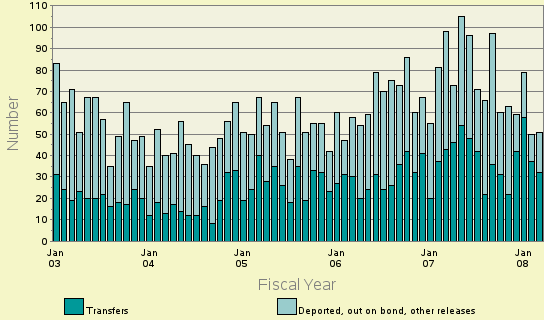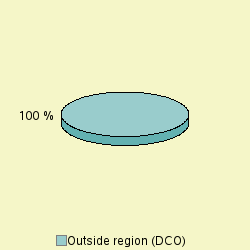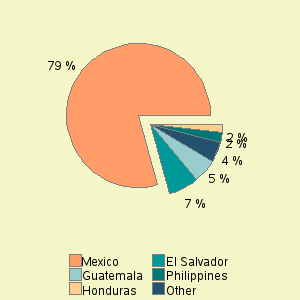Transfers of ICE Detainees from the
Washoe County Jail
Reno, Nevada
Detainees Transferred Number last 12 months 470 Out of total detained 870 Percent change: from previous 12 months 25 % from FY 2005 43 % from FY 2000 495 % Facility ranking on transfers top 30 %
Table 1: TransfersDuring the most recent 12 month period for which data are available, a total of 470 detainees were transferred by Immigration and Customs Enforcement (ICE) from the Washoe County Jail where they had been temporarily housed to other facilities. The average stay for these individuals before their transfer was 4 days. The use of this facility for the temporary housing of federal immigration detainees was arranged through an intergovernmental service agreement (IGSA) under which payments by ICE to another governmental agency are made for housing federal detainees. Additional information about the arrangement, including whether a private company may operate the facility for the government, was not available at the time this report was posted.
Transfers made up 54 percent of the 870 detainees who in one way or another left this facility during the last 12 months. This report focuses just on these transfers. The remaining 46 percent of individuals who departed from the Washoe County Jail last year actually left ICE detention. These individuals were deported from the country, released under supervision while their cases was being decided, or left ICE detention for a variety of other reasons. For more information on this facility please see additional TRAC reports in this series.
This report series is based upon analyses conducted by the Transactional Records Access Clearinghouse (TRAC) at Syracuse University of 3.4 million government records tracking each individual who passed through an ICE detention facility during the past decade. The most recent 12 month period for which comprehensive data are available is for April 2007 through March 2008. See About the Data.
How This Facility Ranks Nationally
Detainee transfer rankings. The Washoe County Jail was one of 1,528 facilities that were used to house immigration detainees during the last decade, and one of 654 facilities nationwide that housed ICE detainees during the most recent 12 month period. Of these 654, there were 403 facilities that had at least 10 ICE detainee transfers last year. Excluding those facilities with fewer than 10 transfers, the Washoe County Jail last year ranked in the top 30 percent nationwide in the number of individuals it transferred to other ICE facilities. This means that 30 percent of the locations contributed the same or a larger numbers of transfers, while 70 percent had a smaller number. See Table 1.
Average length of stay before transfer. Once detainees arrived at the Washoe County Jail their average length of stay before being transferred on to another ICE facility was 4 days last year. Ranking facilities from longest to shortest detention stays for their transfer population, this average of 4 days placed Washoe County Jail in the top 62 percent of all facilities nationwide. That is, for detainees who are transferred, 62 percent of ICE detention facilities have the same or longer average stays last year, while 38 percent of detention facilities had shorter average stays.
Trends in the Number of Detainees Transferred
Transfers last year. When the ICE detainee transfers during the April 2007-March 2008 period were compared with those in the previous 12 months, the Washoe County Jail numbers were up by 25 percent. During the previous April 2006-March 2007 period the facility processed 376 transfers as compared with 470 last year. As detailed in Table 1, transfers last year were also up by 43 percent as compared with the number of transfers (328) during FY 2005. Transfers last year were also up by 495 percent as compared with the number of transfers (79) during FY 2000.
Longer term transfer trends. Greater detail on these long-term trends in ICE transfers from the Washoe County Jail are displayed in Figure 1. Here the month-by-month number of transfers are graphed against the backdrop of the total detainees leaving the custody of this facility. Transfers are displayed with darker shading while those deported or released appear with lighter shading. As is readily apparent, considerable variation has occurred over time in both the overall numbers of detainees as well as the volume of transfers during this period.
Fiscal Year ICE Detainees Total Transfers Percent 1999 534 160 30 % 2000 404 79 20 % 2001 508 147 29 % 2002 739 236 32 % 2003 705 248 35 % 2004 550 183 33 % 2005 663 328 49 % 2006 727 337 46 % 2007 955 463 48 % 2008 (est) 816 478 59 %
Table 2: Detainee transfers from this facility over the last decade
Transfer trends for the last decade are summarized by fiscal year in Table 2. Year-by-year figures for the Washoe County Jail are given for the total number of detainees as compared with the number transferred from the facility. The percent of detainees that end up being transferred from the facility is also given. (As mentioned above, the remaining detainees end up deported, released under supervision, or leave ICE detention for some other reason.) Because data for all twelve months of the most recent fiscal year are not yet available, the FY 2008 numbers (October 2007 through September 2008) are estimated based upon reporting for the first six months.
Origins and Destinations
Were these detainees arrested locally? Where did those that ended up being transferred from the Washoe County Jail last year originate? Information on the place of arrest was not included in the available data ICE released. However, we can examine whether the Washoe County Jail was the first ICE facility in which these detainees were held. According to ICE records, for all these detainees, the Washoe County Jail was the first place they were sent when they were detained by ICE. The remaining 0 percent had been transferred in from another ICE detention facility.
How soon did transfers occur? Nationally, the median number of days before an ICE detainee is transferred to another facility was 3 days last year. That means that half of all transfers occurred on or before the third day, while half had longer stays before they were transferred on to another ICE facility. Note that nationally the average stay at an ICE detention facility before an individual is transferred is substantially longer - 18 days. This is because while most detainees have relatively short stays before ICE transfers them elsewhere, sometimes stays are lengthy and these lengthy stays raise the average to above the median stay of 3 days.
For the Washoe County Jail last year, the median stay before a detainee was transferred was 4 days. This is longer than the national figure. The average stay before transfers occurred was the same - 4 days - than the median stay. As noted above, this figure placed the facility in the top 62 percent among ICE detention facilities nationwide in the average number of days a detainee spent before he or she was transferred.
Where did those transferred get sent? ICE currently has great discretion about where in the United States transferred detainees are sent. For the period covered by these data, ICE divided the country into geographic regions or areas and assigned each to one of 56 document control offices or DCOs for the purpose of keeping track of detainees. Available data allow us to examine whether the transfer occurred within the same DCO or the transfer was to a different DCO. For the nation as a whole during the latest 12 months, about six out of ten transfers (59 percent) were within the same DCO, while the remaining four out of ten (41 percent) were to a different DCO.
Transfers Facility Profile U.S Overall
Profile (%)Number Percent Within region (DCO) 0 0.0% 59% Outside region (DCO) 470 100% 41% Total 470 100% 100%
Table 3: Transfer destinations during last 12 months
Figure 2 and accompanying Table 3 provide some comparative figures for how the Washoe County Jail stacks up against this national pattern. Last year, none of the transfers from the Washoe County Jail were to locations in the same region -- facilities under the control of same ICE docket control office. All of the transfers went to detention facilities in a different region (DCO).
Nationalities
Which nationalities predominate? Last year in the United States, individuals from Mexico comprised the largest number of those transferred by ICE. Some 37 percent of all transfers recorded Mexico as their country of origin. The Washoe County Jail had a much larger proportion of detainees from Mexico - 79 percent - among their transfers. Detainees from Mexico were also the largest single nationality group among the transfers at the facility.
Nationalities Ranked in Top 10 Transfers Total To Diff. DCO % Diff DCO - ALL 470 470 100.0 % 1 Mexico 373 373 100.0 % 2 El Salvador 32 32 100.0 % 3 Guatemala 25 25 100.0 % 4 Philippines 11 11 100.0 % 5 Honduras 8 8 100.0 % 6 Laos 3 3 100.0 % 7 Canada 2 2 100.0 % Colombia 2 2 100.0 % 9 Bangladesh 1 1 100.0 % Costa Rica 1 1 100.0 % Cuba 1 1 100.0 % Fiji 1 1 100.0 % Germany 1 1 100.0 % India 1 1 100.0 % Indonesia 1 1 100.0 % Jordan 1 1 100.0 % Moldova 1 1 100.0 % Nicaragua 1 1 100.0 % Poland 1 1 100.0 % Russia 1 1 100.0 % Trinidad and Tobago 1 1 100.0 % Vietnam 1 1 100.0 %
Table 4: Transfers by nationality during the last 12 months
In descending order, the other top nationalities after Mexico that made up transfers from the Washoe County Jail last year were: El Salvador (7%), Guatemala (5%), Philippines (2%) and Honduras (2%).
For the frequency for each of the nationalities among transfers from the Washoe County Jail last year see Table 4.



